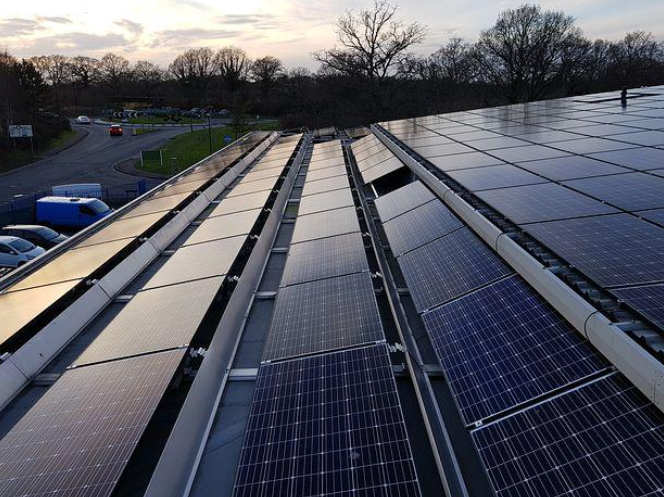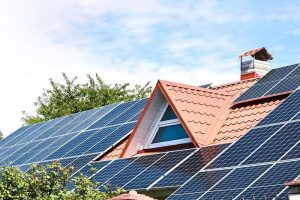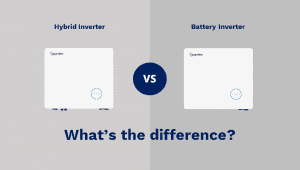Sizing the inverter: What size inverter do I need?
Solar panels are used to convert the sun’s energy into electricity, which can be used to power any electrical appliance. However, to make the electricity usable for many of these appliances, you need an inverter.
While inverters are a necessary piece of equipment for solar set-ups, they come in a range of sizes (or capacities), and choosing the right one can be a little tricky. In fact, one of the most common questions we hear from customers is: “What size inverter do I need?”
This article aims to help you answer this question. Read on to learn more about what inverters do and how to go about sizing an inverter for a solar system.
Do I need an inverter?
If you have a solar system, then yes, you do need an inverter. Inverters are a vital part of any solar energy set-up as they convert the direct current (DC) generated by the panels into alternating current (AC).
Without an inverter installed in your solar system, you would only have access to DC electricity coming directly from your panels. AC is the form of energy used by the grid and what powers most household appliances, so the inverter makes your solar energy usable.
What can I run with a solar inverter?
The majority of household appliances and a lot of commercial equipment run on AC electricity. There are several reasons for this. For example, DC electricity loses more energy in the form of heat, so it is more expensive and difficult to transport. It is also related to safety, with DC electricity carrying a greater risk of fire.
Some common examples of appliances that run on AC power include:
- Air conditioners
- Power tools such as drills, grinders, sanders, and saws
- Refrigerators
- Televisions
- Computers
- Electric lights
- Microwaves
- Blenders and other kitchen appliances
- Washing machines and dryers
- Dishwashers
One big exception to this is any device or appliance that is powered using a battery. Battery-powered items rely on DC for charging, meaning mobile phones, laptops, and electric cars all require a DC input.
How do I choose the size of the inverter?
Inverters for solar range in size, so it can be difficult to know which is the right fit for your solar set-up. Thankfully, it’s not quite as complex as it may seem at first. Solar inverters are rated in watts (W), as are solar panels themselves, making it relatively simple to match the correctly sized inverter to your system. However, there are a variety of other factors you should take into account when choosing your inverter size.
The rating of your photovoltaic (PV) array
The main thing you’ll need to consider when choosing the size of your solar inverter is the size of your solar array. The purpose of an inverter is to convert the DC electricity produced by your solar panels into AC so it can power a range of common appliances. This means the inverter has to be able to deal with the quantity of energy it’s receiving from the panels.
As a basic estimate, you should try to roughly match the size of the inverter to the size of the solar array. Solar arrays are generally rated in kilowatts (kW), so you can easily match the ratings. For example, you may have a 3 kW solar array installed on your roof, so the ideal inverter size is likely to be around 3 kW as well (or 3,000 W). The ratings don’t necessarily need to match exactly, but it should give you a good general idea.
Helpfully, manufacturers will usually provide a comparison table with recommended array capacities that can be matched with a specific inverter. It’s important to pay attention to these recommendations as failing to follow them could have implications for your warranty.
The size of your building
The size of your building is important when sizing an inverter for a solar system. This is because the capacity of your solar array is directly linked to the number of panels you can fit in your array, and solar panels are usually mounted on a building’s roof. Therefore, building size is a key factor in array capacity and, consequently, inverter size.
Where you are in the world
The location of your solar array is another factor that can influence your choice of inverter. This is due to the effect that location can have on solar panel productivity. As an extreme example, a solar array in the Australian outback is going to be consistently more productive than an identical set-up in Scotland, simply due to the higher levels of sunlight in the former.
An inverter only needs to be able to handle the amount of energy being produced by the array it’s connected to, so it’s pointless installing one that’s too big for the amount of energy that’s being produced. In practice, this means that you can generally use an inverter rated slightly lower than your array’s rating in less sunny areas. On the other hand, if you want that solar system in the Australian outback, you’ll need an inverter that’s sized closer to the array’s rating.
However, in addition to the amount of sunlight, temperature is also a factor in solar panel efficiency. Therefore, if the location you’re installing solar panels in regularly experiences very high temperatures, you can probably also use a relatively small inverter (compared with the same system in a cooler climate).
Individual factors of your site and array placement
Beyond array size, building size, and location, there are several other factors related to the specific placement and design of your array that can influence what size of inverter you’ll need. For example, the level of tilt of your panels, as well as their orientation relative to the sun, will have a significant impact on their productivity.
Additionally, there are a number of environmental factors that may affect the amount of sunlight hitting the panels to consider. These can include things such as the amount of shade (i.e., from trees or neighboring buildings), the level of dust or pollution in the air, and more.
Your installer should take all these environmental factors into consideration when surveying, as they will influence the system size you need and what kind of electricity production you can expect in reality (not just in perfectly controlled lab conditions). If any of these environmental factors is going to reduce your array’s productivity, then you will most likely be able to use a smaller inverter.
How do I work out what size inverter is required?
Regardless of your solar set-up, the “right size” for an inverter is more of a sliding scale, as multiple inverters will work with any array. The rating of your solar inverter can actually be higher or lower than that of your solar array, within a certain range, without significantly compromising performance.
When calculating the required solar panel inverter size for your array, an important figure to determine is the array: inverter ratio. This ratio is the DC capacity of your solar panel array divided by the maximum AC output of a specific inverter. For example, a 3 kW solar array with a 3,000 W inverter installed would have an array: inverter ratio of exactly 1. The same array with a 2,500 W inverter would have an array: inverter ratio of 1.2. Most solar set-ups have a ratio slightly above 1, but usually not more than 1.25, and the highest ratio generally recommended by companies selling inverters is around 1.5-1.55.
One scenario where a higher ratio is feasible is when the solar array’s productivity is limited by something such as low levels of sunlight, pollution or dust in the air, or suboptimal placement of panels. Smaller inverters are generally more affordable than larger ones, so in these kinds of situations, it can make financial sense to have a smaller inverter.
However, if there’s too much of a discrepancy between the array capacity and the inverter size (i.e., if your array capacity is a lot higher than that of your inverter) then you may suffer from something known as clipping, which you should always try to avoid. Clipping is where your inverter cannot process the amount of electricity being produced and excess energy is lost. Over time, these losses can significantly outweigh the savings made by purchasing a smaller inverter.
Using an inverter that is too large is also inadvisable. Inverters work at optimal efficiency when operating at (or close to) their maximum capacity. Therefore, using an inverter that is considerably larger than your solar array can make the inverter less efficient.
What size solar inverter do I need?
The type of inverter and size of inverter you need will depend on many factors and is going to be different in every situation.
One big factor we haven’t yet covered is price, but this is arguably going to be the most important factor for most people. As a general rule, the larger the capacity of an inverter, the higher the price, all else being equal. However, there are many different types of inverter, as well as different price brackets based on inverter quality.
This is relevant as the highest-quality inverters may be significantly more efficient than lower-priced options, meaning you may be able to use a slightly smaller inverter with the same solar panel set-up.
Overall, it’s best to use a set-up with an array:inverter ratio of around 1.2, give or take a little depending on price and other factors like the amount of sunlight in your area.
In short, if you’ve considered all the factors discussed above and spoken to your installer about recommended inverters, and roughly matched the inverter size to the array capacity, then you’re unlikely to go too far wrong. As always, talk to an expert if you need advice about sizing your inverter. Solar systems are an excellent investment for the future, but it’s important you’re getting the highest performance possible to maximize your return on this investment.




